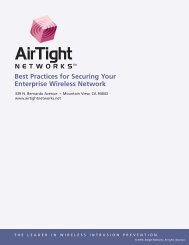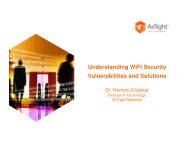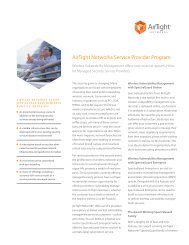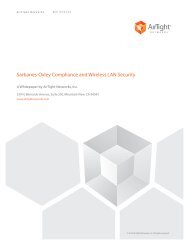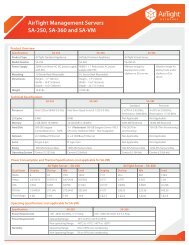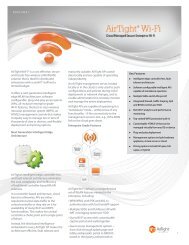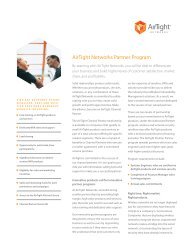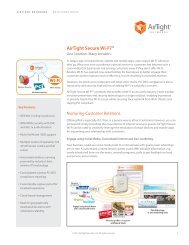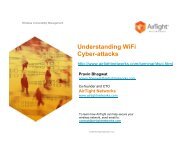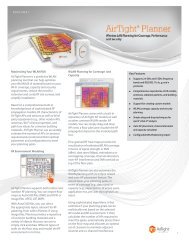WPA Too "Hole196" - AirTight Networks
WPA Too "Hole196" - AirTight Networks
WPA Too "Hole196" - AirTight Networks
You also want an ePaper? Increase the reach of your titles
YUMPU automatically turns print PDFs into web optimized ePapers that Google loves.
TOO!<br />
<strong>WPA</strong> 2<br />
“Hole196”<br />
Md Sohail Ahmad<br />
<strong>AirTight</strong> <strong>Networks</strong><br />
www.airtightnetworks.com<br />
© <strong>AirTight</strong> <strong>Networks</strong>. All rights reserved.
A lot of speculations about “Hole196” !<br />
© <strong>AirTight</strong> <strong>Networks</strong>. All rights reserved.
Where did we find<br />
this “Hole196” ?<br />
© <strong>AirTight</strong> <strong>Networks</strong>. All rights reserved.
Buried inside the IEEE 802.11 standard<br />
for the last six years<br />
Hole 196!!!<br />
It’s right here!<br />
© <strong>AirTight</strong> <strong>Networks</strong>. All rights reserved.
The Talk is<br />
NOT about:<br />
Unauthorized user gaining access to <strong>WPA</strong>2 secured<br />
network, or<br />
Cracking private key of a <strong>WPA</strong>2 user<br />
About:<br />
An insider attack, which can be carried out by a<br />
malicious user present inside the network<br />
© <strong>AirTight</strong> <strong>Networks</strong>. All rights reserved.
Can you sniff private in-flight data of<br />
other WiFi users?<br />
Wired LAN Segment<br />
Traffic encrypted<br />
with the private<br />
key of Client1<br />
Traffic encrypted<br />
with the private<br />
key of Client2<br />
WiFi Client 1<br />
(Malicious Insider)<br />
WiFi Client 2<br />
© <strong>AirTight</strong> <strong>Networks</strong>. All rights reserved.
Can you sniff private in-flight data of<br />
other WiFi users?<br />
Wired LAN Segment<br />
Honeypot style of attack will<br />
not work!<br />
X<br />
Malicious Insider<br />
Honeypot AP<br />
WiFi Client 2<br />
© <strong>AirTight</strong> <strong>Networks</strong>. All rights reserved.
Can you sniff private in-flight data of<br />
other WiFi users?<br />
Wired LAN Segment<br />
Spoofed ARP Request<br />
(I am the Gateway)<br />
Existing wired IDS/IPS can<br />
catch ARP spoofing attack!<br />
WiFi Client 1<br />
(Malicious Insider)<br />
WiFi Client 2<br />
© <strong>AirTight</strong> <strong>Networks</strong>. All rights reserved.
No key cracking! No brute force!<br />
Wired LAN Segment<br />
Traffic encrypted<br />
with the private<br />
key of Client1<br />
Traffic encrypted<br />
with the private<br />
key of Client2<br />
WiFi Client 1<br />
(Malicious Insider)<br />
WiFi Client 2<br />
© <strong>AirTight</strong> <strong>Networks</strong>. All rights reserved.
Encryption Keys<br />
Two types of keys for data encryption<br />
1. 1. Pairwise Transient Key (PTK)<br />
2. 2. Group Temporal Key (GTK)<br />
While PTK is used to protect unicast data<br />
frames , GTK is used to protect group<br />
addressed data frames e.g. broadcast ARP<br />
request frames.<br />
<strong>WPA</strong>2<br />
© <strong>AirTight</strong> <strong>Networks</strong>. All rights reserved.
PTK is unique, derived per session<br />
Wired LAN Segment<br />
Traffic encrypted<br />
with PTK1<br />
Traffic encrypted<br />
with PTK2<br />
Private Key<br />
PTK1<br />
WiFi Client 1<br />
WiFi Client 2<br />
Private Key<br />
PTK2<br />
© <strong>AirTight</strong> <strong>Networks</strong>. All rights reserved.
GTK is shared among all associated clients<br />
Your Group key is GTK1<br />
Newly<br />
associated client<br />
Client 1<br />
PTK = PTK1<br />
Group key = GTK1<br />
Client 2<br />
PTK = PTK2<br />
Group key = GTK!<br />
Client 3<br />
PTK = PTK3<br />
Group key = GTK1<br />
Three connected clients<br />
© <strong>AirTight</strong> <strong>Networks</strong>. All rights reserved.
<strong>WPA</strong>2 standard defines GTK as a one-way key<br />
Destination MAC = FF:FF:FF:FF:FF:FF<br />
ARP Req<br />
GTK should be used as an encryption key by an AP<br />
and as a decryption key by a wireless client<br />
© <strong>AirTight</strong> <strong>Networks</strong>. All rights reserved.
A WiFi client always keeps a copy of GTK<br />
wpa_supplicant software is used on WiFi client devices.<br />
The log of wpa_supplicant software shows that GTK is always<br />
known to a WiFi client device<br />
© <strong>AirTight</strong> <strong>Networks</strong>. All rights reserved.
A malicious client can inject encrypted group<br />
addressed data frames to other clients<br />
Malicious insider can<br />
inject forged group<br />
addressed data traffic<br />
Broadcast frame<br />
Encrypted with GTK<br />
Legitimate clients<br />
can not detect data<br />
forgery<br />
© <strong>AirTight</strong> <strong>Networks</strong>. All rights reserved.
Exploit #1: Stealth ARP Poisoning<br />
Wired LAN<br />
Victim’s data encrypted<br />
with Attacker’s PTK<br />
3<br />
2<br />
Victim’s data encrypted<br />
with Victim’s PTK<br />
Attacker<br />
1<br />
I am the Gateway<br />
(Encrypted with GTK)<br />
Victim<br />
1 Attacker injects fake ARP Request packet<br />
to poison client’s cache for gateway.<br />
2<br />
Victim sends all traffic encrypted with its PTK<br />
to the AP, with Attacker as the destination<br />
(gateway)<br />
© <strong>AirTight</strong> <strong>Networks</strong>. All rights reserved.<br />
3<br />
AP forwards Victim’s data to the Attacker<br />
encrypting it in the Attacker’s PTK. So<br />
Attacker can decrypt Victim’s private data.
Man-in-the-middle (MITM) Attack<br />
Wired LAN<br />
Attacker forwards victim data to<br />
actual Gateway to provide a<br />
transparent service to the victim<br />
4<br />
Victim<br />
Attacker<br />
I am the Gateway<br />
(Encrypted with GTK)<br />
Victim<br />
Victim<br />
© <strong>AirTight</strong> <strong>Networks</strong>. All rights reserved.
ARP Poisoning: Detectable vs Stealth<br />
Detectable (Old style)<br />
Stealth (Hole196)<br />
Wired LAN<br />
Wired LAN<br />
I am the<br />
Gateway<br />
Malicious insider<br />
Victim<br />
Malicious insider<br />
I am the Gateway<br />
Encrypted with GTK<br />
Victim<br />
Spoofed ARP Request frames are sent on<br />
the wire and wireless medium by an AP. The<br />
attack can be detected by wired IDS/IPS.<br />
Spoofed ARP Request frames are not<br />
sent to AP and never go on wire; hence<br />
cannot be detected by wired IDS/IPS<br />
© <strong>AirTight</strong> <strong>Networks</strong>. All rights reserved.
Exploit #2: IP Level Targeted Attack<br />
Any data payload can be encapsulated in the group addressed IEEE<br />
802.11 data frames<br />
IP Layer Unicast Data Frame<br />
Flag<br />
Duration<br />
Address 1 =<br />
FF:FF:FF:FF:FF:FF<br />
Address 2 =<br />
AP’s BSSID<br />
Address 3 =<br />
Src MAC Address<br />
Seq.<br />
No<br />
Encapsulated<br />
Data Payload<br />
FCS<br />
IEEE 802.11 Data Packet<br />
© <strong>AirTight</strong> <strong>Networks</strong>. All rights reserved.
Example: Port Scanning<br />
SYN Frame<br />
Flag<br />
Duration<br />
Address 1 =<br />
FF:FF:FF:FF:FF:FF<br />
Address 2 =<br />
AP’s BSSID<br />
Address 3 =<br />
Src MAC Address<br />
Seq.<br />
No<br />
Encapsulated<br />
Data Payload<br />
FCS<br />
IEEE 802.11 Data Packet<br />
What else is possible ?<br />
- Buffer overflow exploit<br />
- Malware Injection<br />
- ???<br />
© <strong>AirTight</strong> <strong>Networks</strong>. All rights reserved.
Replay Detection in <strong>WPA</strong>2<br />
48 bit Packet Number (PN) is present in all encrypted DATA frames<br />
Replay Attack Detection in <strong>WPA</strong>2<br />
1. All clients learn the PN associated with a GTK<br />
at the time of association<br />
2. AP sends a group addressed data frame to all<br />
clients with a new PN<br />
3. If new PN > locally cached PN, then packet is<br />
decrypted and after successful decryption,<br />
cached PN is updated with new PN<br />
Access Point<br />
PN=701<br />
Expecting<br />
PN >700<br />
Legitimate client<br />
© <strong>AirTight</strong> <strong>Networks</strong>. All rights reserved.
Exploit #3: WDoS on Broadcast Downlink Traffic<br />
A malicious user can advance the locally cached PN (replay counter) in all<br />
peer clients by forging a group addressed data frames with a very large PN<br />
PN = 780 PN = 780<br />
Malicious<br />
client<br />
GTK encrypted broadcast<br />
data frame PN = 9999<br />
PN = 781<br />
PN = 782<br />
PN = 783<br />
…….<br />
X<br />
X<br />
X<br />
Legitimate<br />
client<br />
Client updates PN.<br />
New PN = 9999<br />
Client checks PN. New<br />
PN (781) < local PN<br />
(9999)<br />
Packets are dropped<br />
until PN reaches 9999<br />
© <strong>AirTight</strong> <strong>Networks</strong>. All rights reserved.
POC: GTK Exploit<br />
Few lines of code + Off‐the‐shelf hardware<br />
© <strong>AirTight</strong> <strong>Networks</strong>. All rights reserved.
Open Source Software: Madwifi & <strong>WPA</strong><br />
Supplicant Software<br />
wpa_supplicant (0.7.0)<br />
Supplicant software is used to pass updated GTK and PN to be by madwifi<br />
driver<br />
Madwifi (0.9.4)<br />
Software is modified to create spoofed group addressed data frames<br />
with sender as AP address<br />
© <strong>AirTight</strong> <strong>Networks</strong>. All rights reserved.
Modification in the madwifi driver<br />
Broadcast IEEE 802.11 Frame<br />
Address 1 Address 2 Address 3<br />
ToDS<br />
Flag<br />
Duration<br />
AP’s MAC<br />
(BSSID)<br />
Client’s MAC Address<br />
FF:FF:FF:FF:FF:FF<br />
Seq.<br />
No<br />
Receiver Transmitter Final Destination<br />
FromDS<br />
Flag<br />
Duration<br />
FF:FF:FF:FF:FF:FF<br />
AP’s MAC<br />
(BSSID)<br />
Client’s MAC Address<br />
Seq.<br />
No<br />
Receiver Transmitter Original Sender<br />
© <strong>AirTight</strong> <strong>Networks</strong>. All rights reserved.
Modification in the madwifi driver<br />
1. Cyclic shift of addresses, convert ToDS flag into<br />
FromDS: 4 Lines<br />
Address 1 Address 2 Address 3<br />
ToDS<br />
FromDS<br />
Flag<br />
Flag<br />
Duration<br />
Duration<br />
AP’s MAC<br />
(BSSID)<br />
FF:FF:FF:FF:FF:FF<br />
Client’s MAC Address<br />
AP’s MAC<br />
(BSSID)<br />
FF:FF:FF:FF:FF:FF<br />
Client’s MAC Address<br />
Seq.<br />
No<br />
Seq.<br />
No<br />
10 lines of<br />
driver code<br />
to exploit<br />
GTK<br />
vulnerability!<br />
2. Selection of right key for frame encryption: 6 Lines<br />
© <strong>AirTight</strong> <strong>Networks</strong>. All rights reserved.
Demo: Stealth mode MITM attack<br />
The Arsenal of MITM Attack<br />
Cain & Abel<br />
Ettercap<br />
Delegated/DNSSpoof<br />
SSLSniff<br />
SSLSTRIP<br />
…<br />
Malicious<br />
Insider<br />
Victim<br />
© <strong>AirTight</strong> <strong>Networks</strong>. All rights reserved.
Who is vulnerable to “Hole196” ?<br />
All implementation of <strong>WPA</strong> and <strong>WPA</strong>2, regardless of<br />
•Type of encryption used in the network (AES or TKIP)<br />
•Type of authentication used in the network ( PSK or<br />
802.1x/EAP)<br />
•Type of WLAN architectures (Standalone, Locally controlled<br />
or Centrally Controlled)<br />
© <strong>AirTight</strong> <strong>Networks</strong>. All rights reserved.
Countermeasures
The Real Fix: Protocol Enhancement<br />
• Deprecate use of GTK and group addressed data traffic<br />
1. For backward compatibility AP should send randomly generated<br />
different GTKs to different clients so that all associated clients have<br />
different copy of group key<br />
2. AP should deliver group addressed data traffic by converting them into<br />
unicast traffic<br />
Disadvantages:<br />
a. Impact on network throughput<br />
b. Requires AP software upgrade (Not going to happen overnight !)<br />
© <strong>AirTight</strong> <strong>Networks</strong>. All rights reserved.
What should we do now?
Can we rely on end point security software?<br />
Client software such as DecaffeintID or Snort detects change in<br />
the ARP cache.<br />
Detects ARP Cache Poisoning attack<br />
Limitations:<br />
1. Client software is available only for limited<br />
operating systems and hardware platforms<br />
2. Not enterprise grade; Impractical to manually install<br />
on large number of endpoints<br />
© <strong>AirTight</strong> <strong>Networks</strong>. All rights reserved.
Can we rely on WLAN infrastructure ?<br />
Public Secure Packet Forwarding (PSPF)/peer-to-peer (P2P) or<br />
Client Isolation<br />
Hello B, This is A<br />
X<br />
A’s packet is not<br />
forwarded to B<br />
Client A<br />
Client B<br />
Legitimate users might want to download songs/pics from say<br />
laptop to smartphone!<br />
What’s about Voice-over-WiFi deployment ?<br />
© <strong>AirTight</strong> <strong>Networks</strong>. All rights reserved.
Can we rely on Wireless Monitoring Systems<br />
(WIPS/WIDS) ?<br />
Similar to WEP Cracking, Skyjacking<br />
and <strong>WPA</strong>‐TKIP, Hole 196 exploit is<br />
carried out entirely over the air<br />
WIPS can serve as an additional layer of defense in detecting and<br />
protecting from such attacks<br />
© <strong>AirTight</strong> <strong>Networks</strong>. All rights reserved.
Concluding Remarks<br />
• All <strong>WPA</strong>2 networks are exposed with the “Hole 196” vulnerability; Inter<br />
user privacy is broken in <strong>WPA</strong>2<br />
• The real fix requires enhancement in the <strong>WPA</strong>2 protocol. In long term,<br />
standard can fix the problem but in short term AP vendors should provide<br />
a patch (proprietary solution)<br />
• In the mean time, enterprises should consider turning ON Client isolation<br />
(PSPF) features on their WLANs and use endpoint security (ARP<br />
poisoning detector like Snort or other higher layer security like IPSec)<br />
• A multi-layered security approach should be adopted; A dedicated WIPS<br />
monitoring the airspace 24/7 can detect and mitigate zero-day<br />
vulnerabilities such as “Hole 196”<br />
© <strong>AirTight</strong> <strong>Networks</strong>. All rights reserved.
Be Aware, Be Secure !<br />
Thank You<br />
Md Sohail Ahmad<br />
md.ahmad@airtightnetworks.com<br />
www.airtightnetworks.com<br />
For up-to-date information on developments in wireless<br />
security, visit<br />
blog.airtightnetworks.com<br />
© <strong>AirTight</strong> <strong>Networks</strong>. All rights reserved.



